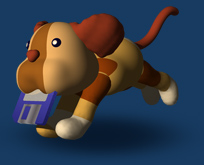Your best friend for file transfer.
 Fetch
Fetch
Moving Shortcuts to Leopard (4 posts)
- Started 16 years ago by scotthopkins
- Latest reply 16 years ago from Scott McGuire
-
scotthopkins Member
-
Scott McGuire Administrator
Hi Scott,
If you are technically inclined (otherwise skip to paragraph 3): if you are using Fetch 5.1 or later, the Fetch Shorcuts are stored in a file called "com.fetchsoftworks.Fetch.Shortcuts.plist" in the Preferences folder inside the Library folder inside your Home folder.
You should quit Fetch if it's running, find that file on your external drive, and copy it to the same location on your clean install. (If you've run Fetch already on the clean install, it may warn you that you're replacing a newer file with an older one - but that's okay, since you haven't set up any new shortcuts on the clean install - just make sure you are copying in the correct direction!)
Or, if you don't want to mess around trying to find files in the Library folders, and can boot off the external drive, you can follow our instructions in the Moving shortcuts to another Macintosh help topic. Booting off the external drive would be the "old Macintosh" and the clean install would be the "new Macintosh."
Note that Fetch 5.1 and later store passwords for shortcuts in your keychain, so moving the shortcuts file from one system to another will move all the information about your shortcuts except the passwords. While one solution is to simply re-enter your passwords on the new system (where they will be saved in that Macintosh's keychain), there are ways to move the keychain data as well (such as the Mac OS X Migration Assistant).
Please let us know if you have further questions.
Thanks,
Scott McGuire
Fetch Softworks -
scotthopkins Member
Scott, thanks for the quick reply. Copying over the preference did the trick and my Keychain was already synced so I'm in great shape.
Scott
Originally posted by ScottMcGuire:
Hi Scott,
If you are technically inclined (otherwise skip to paragraph 3): if you are using Fetch 5.1 or later, the Fetch Shorcuts are stored in a file called "com.fetchsoftworks.Fetch.Shortcuts.plist" in the Preferences folder inside the Library folder inside your Home folder.
You should quit Fetch if it's running, find that file on your external drive, and copy it to the same location on your clean install. (If you've run Fetch already on the clean install, it may warn you that you're replacing a newer file with an older one - but that's okay, since you haven't set up any new shortcuts on the clean install - just make sure you are copying in the correct direction!)
Or, if you don't want to mess around trying to find files in the Library folders, and can boot off the external drive, you can follow our instructions in the Moving shortcuts to another Macintosh help topic. Booting off the external drive would be the "old Macintosh" and the clean install would be the "new Macintosh."
Note that Fetch 5.1 and later store passwords for shortcuts in your keychain, so moving the shortcuts file from one system to another will move all the information about your shortcuts except the passwords. While one solution is to simply re-enter your passwords on the new system (where they will be saved in that Macintosh's keychain), there are ways to move the keychain data as well (such as the Mac OS X Migration Assistant).
Please let us know if you have further questions.
Thanks,
Scott McGuire
Fetch Softworks -
Scott McGuire Administrator
Hi Scott,
You're welcome, and we're glad to hear you're all set.
Best,
Scott McGuire
Fetch Softworks
- Page 1

I did a clean install of Leopard, but still have my old system on an external drive. How can I copy my Shortcuts from it into Fetch on Leopard now?
Thanks,
Scott
Posted 16 years ago #